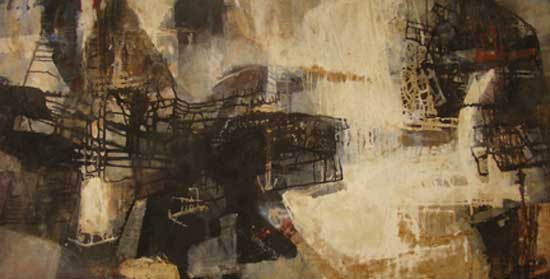
Abstraction in Cuba. Guido Llinás, Raúl Martínez and
Lolo Soldevilla. Project Room: Raul Milián
From April 6 through June 2, 2012
Pan American Art Projects
2450 NW 2nd Avenue
Miami, FL 33127
Lately we have seen a revitalized interest in the work of a group of Cuban artists that were very active in the fifties and early sixties. These artists introduced to Cuba’s predominantly figurative art of the period the then novel abstract tendencies that were coming first from Europe and later from the United States.
The first indication of this trend in Cuba can be traced to the late forties with Sandu Darie’s first exhibition at the Lyceum. In 1953 the group Los Once (The Eleven), perhaps the most famous association of Cuban abstract artists came along. This group for the first time took abstraction as its creative umbrella, and organized exhibitions. Los Once (Guido Llinás, Raúl Martínez, Agustín Cárdenas, Hugo Consuegra, Francisco Antigua, Tomás Oliva, René Avila, Ignacio Bermúdez, Fayad Jamis, José Antonio Díaz Peláez, Antonio Vidal, and Viredo Espinosa) would have a brief existence, from 1953 to 1955.
Another group, Diez Pintores Concretos (Ten Concrete Painters), was formed in 1958. This group (Pedro Alvarez, Wilfredo Acay, Salvador Corratgé, Sandu Darie, Luis Martínez Pedro, Alberto Menocal, José Mijares, Pedro de Oraá, Lolo Soldevilla and Rafael Soriano) had their first exhibition in 1959 at Soldevilla’s Gallery Color-Luz, and their last one in 1961, at a fair organized by the Museum of Fine Arts in Havana. Coincidentally that same year Soldevilla’s gallery closed its doors. Abstraction in Cuban Art as a trend would see its conclusion in 1963 with the exhibition Expresionismo Abstracto (Abstract Expressionism) in Galeria Habana.
From this exceptional group of artists we have selected works by two of Los Once, Guido Llinás and Raúl Martínez; Loló Soldevilla from Diez Pintores Concretos and Raul Milián, who worked independently. The exhibition offers a view of the diversity of Cuban abstract art from this period.
Guido Llinás (1923-2005) approached art with an open mind, something we can perceive even today when examining his work. He was interested in the qualities of the materials, such as burlap which was considered unsuitable by many of his peers, and also in the infinite possibilities that color offered him. Llinás was looking for texture, which perhaps was what took him to make his adventurous collages. His sense of space and composition were quite unique, making possible for him to create bold pieces. Llinas lived most of his life in Paris, France, where he died in 2005.
Raúl Martínez (1927-1995) lived for a while in New York, and he attended the Institute of Design in Chicago, where undoubtedly he was in touch with the latest art tendencies of the moment. He favored Abstract Expressionism, and its influence is evident in his work, especially in the pieces he produced in the decade of the fifties and the early years of the sixties.
Undoubtedly his most visceral work was produced in the fifties. In these pieces we can see his brushstrokes on the canvas, layer upon layer of pure paint, just the pleasure of an aesthetic combination. Although we can see that the composition was solved by pure brushstrokes there is something immediate and at the same time cerebral in the way he made these pieces.
Later on Martínez’s work would deviate into a figurative trend, being one of the first artists in the country that made pieces in a pop style. These later works are perhaps the best known of his oeuvre. Martínez lived most of his life in Cuba, and died in Havana in 1995.
Lolo Soldevilla (Dolores Soldevilla) (1901-1971) was ‘forgotten’ for a long while and then recently ‘discovered’ again. Soldevilla was not only an artist but also a promoter in her own way. Besides her gallery Color-Luz, her house, became the center of meetings and professional discussions, gathering important artists of her time.
Her work was very intimate and experimental, mostly within geometric abstraction. In her pieces we can see her extroverted personality, not afraid of colors or forms. She would actually push those elements to the point of exhaustion, were there would be no other possible solutions. There is also a playful and fresh intent behind her work, almost a challenge to her contemporaries. Soldevilla lived in France for a while and studied there under Vasarely, but lived in Cuba.
Project Room: Raul Milián
Although there wasn’t any other group focused on abstraction after Los Once and Diez Pintores Concretos, isolated artists did most of their oeuvre in this vein. One of them was Raúl Milián (1914-1984). His work shows the continuation and development of abstraction in Cuban art.
Milián’s work is characterized by a very personal and intimate approach. His trademark works in ink are like divertimentos. In these pieces we can see how he balanced the ‘controlled’ line versus the fortuitous, mastering the process. The delicate lines of his compositions make us remember old labyrinths or fantastic maps. A self-taught artist, Milián lived a very private life, almost away from the lights and the public.
Pan American Art Projects
2450 NW 2nd Avenue
Miami, FL 33127
Ph: 305.573.2400
miami@panamericanart.com
www.panamericanart.com
Twitter @panamericanartp

